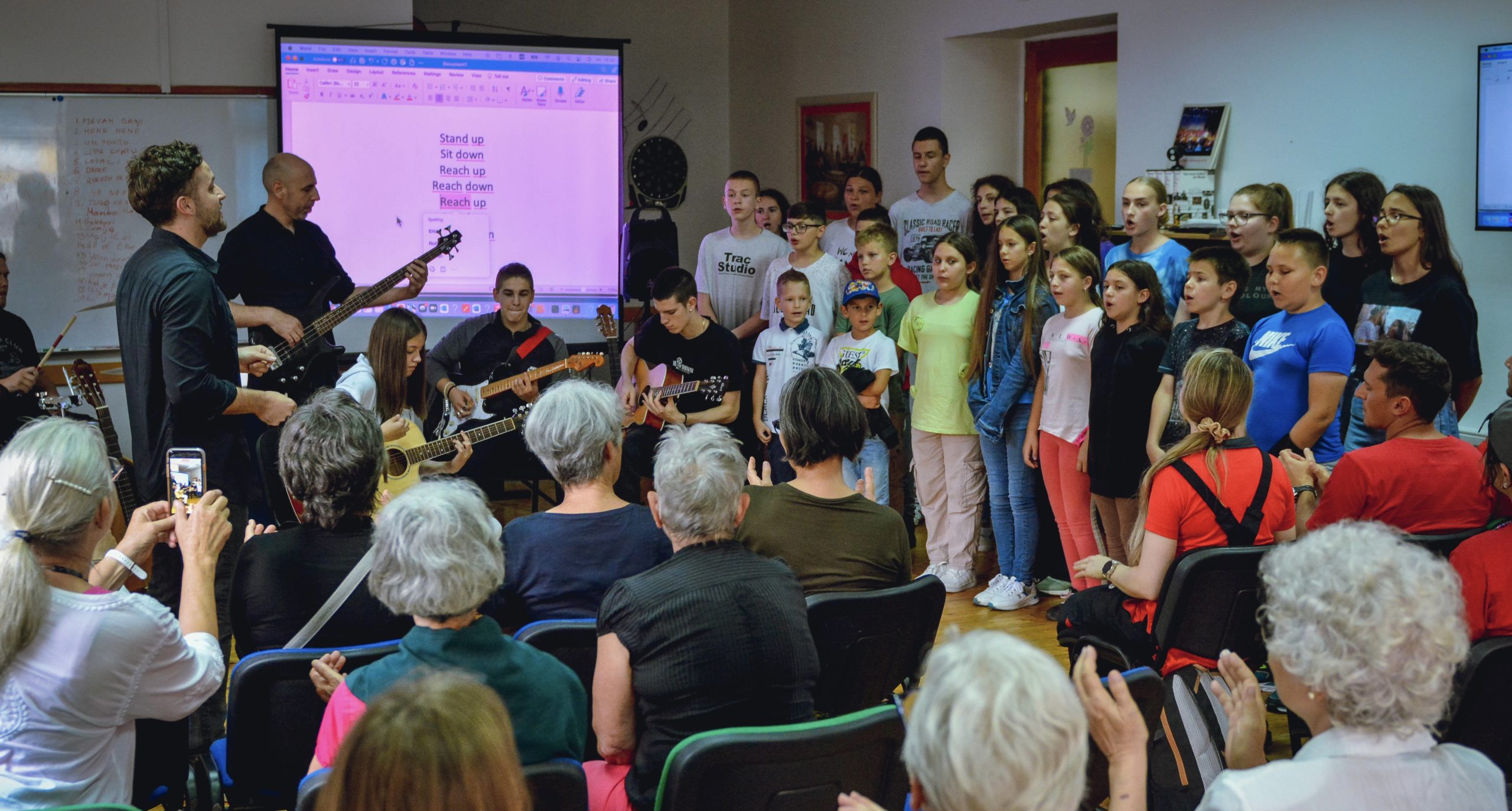
Music is not a magical tool that can be used in isolation to ensure the construction of lasting peace and reconciliation. However, if utilized correctly as a medium, it can provide an excellent means of facilitating dialogue that enables conflict to be discussed in an artistic setting.
Through an exploration of the history of music in Bosnia and Herzegovina, and its historical relationship to conflict and peacebuilding, one is better equipped to grasp the potential of music-based activities to foster cultural reforms towards peace. Individuals and organizations have the capacity to use music in this way to forward the goal of nurturing a culture of peaceful collaboration throughout Bosnia and Herzegovina.
A Brief History of Music in Bosnia and Herzegovina
Music has been a part of Bosnia and Herzegovina’s history and culture for centuries. A large part of Bosnian music is folk-oriented, with the genres of Sevdalinka (or Sevdah) at the forefront. Sevdalinka refers to a style of folk music commonly performed by a vocalist and accompanist that is usually melancholic and focuses on emotions such as love, longing, and nostalgia DiscoverBiH).

More recently, music had a particularly large role in Yugoslavia. Bands such as Plavi Orkestar, Azra, and Zabranjeno Pušenje remain examples of groups who would use messages of peace in their music, and who were not afraid to address the contemporary socio-political climate.
Following instances of conflict and divide such as the 1992-1995 war in Bosnia, the use of music as a tool for peacebuilding has been limited (Zelizer, 2003). In such a delicate post-conflict socio-political structure, traditional means of dialogue have also struggled. Therefore, it is important to emphasize the unlocked potential of alternative, more creative methods of peacebuilding, that include art forms like music.
The Engagement of Music During the War
During the war, the strength of Bosnia’s musical culture was put to the test. A story that is a testament to the resolve of music in Bosnia is that of Muhamed Fazlagić, a Sarajevo born singer. Fazlagić led a group of musicians to Bosnia’s first ever appearance at the 1993 Eurovision contest in Dublin as an independent nation.
Amidst the backdrop of the siege of Sarajevo, Fazlagić described his journey to Eurovision with Escape News in 2015 (Ahmet, 2015). He described conditions of “freezing cold” in the Sarajevo studio where they worked on their entry, freezing due to the lack of heating and poor living conditions in a city cut off from electricity. The group was also forced to embark on a treacherous journey in order to get to the semi-finals in Ljubljana. ‘It was late February, early March and was extremely cold. We literally had to run or walk in the middle of the night through the enemy lines to get to free territory’.
Yet this did not deter him nor his group, and he looks back on the experience with a feeling of ‘enormous pride’ and an ‘even greater win for the Bosnian people’. The opportunity for Bosnia to present its music on the largest stage in Europe during the war was both a testament to the persistence of the Bosnian artists, and the capacity of music to act as a cultural beacon of hope amidst so much pain.
On January 14th, 1995, the ‘Rock under Siege’ concert was held in Sloga Hall, Sarajevo. Despite freezing temperatures and the atrocious living conditions that accompanied being trapped in a war zone, approximately 2,000 young Bosnians attended the concert (Kalender, 2015). This event showed the determination of Bosnia’s young generation, who were exhausted by the crippling ways of life imposed upon them. The concert gave them the opportunity to fight back against the Serb(ian)-led offensive on their city in the form of cultural protest.
This attitude of protest was further advocated by public figures such as Boris Siber, a radio host during the siege. Siber would blare punk music over various radio frequencies in an attempt to block Serb(ian) military radio communications. He described music as a weapon, one of the ways for him to contribute towards using music as an anti-war tool during the siege (Connolly, 2023).
Contemporary Uses of Music in Peacebuilding
Even in times of relative peace, the potential of music and the arts in post-conflict peacebuilding cannot be understated. I sat down with a youth activist from Sarajevo who has asked to remain anonymous. She has spent most of her life as an advocate for the rights of young people throughout Bosnia and Herzegovina, largely through her participation in a variety of local and international organizations and conferences. Through her many years engaging in collaborative arts, including inter-faith choirs and songwriting, she was able to provide me with her opinions on the role of music in building cultures of peace.
When asked about her views on the use of music in contemporary dialogue, she advocates for informal settings as an effective way to explore difficult conversations through music. She explains that ‘music is not the only way, but it is a good tool, and that’s when we are able to create some magic and sustainable social cohesion without knowing it. When we go to conferences and speak about peace and fighting against hate speech, it is a way to consciously discuss these topics. However, when we do it casually through the arts, people are not aware of the impact they make, and it is often even more effective in showing the ability to work together without knowing people’s background.’
She further argues for the importance of people working together towards a collective goal that does not require them to know each other’s ethnicity, such as her choir group. ‘We are able to work together and sing towards the same goal, and you don’t have the feeling of working with people with specific identities, you are just working with people.’
In my conversation with the House of Good Tones, an organization based in Srebrenica that focuses primarily on bringing the local youth together through the arts, their president, Ismar Porić, discussed the importance of music in bonding individuals under complicated circumstances.
The House of Good Tones offers six programs, but Ismar and I focused our discussion on their music program. Its primary objective is to bring children of all backgrounds together. In these classes, children from Srebrenica are given the opportunity to learn a specific instrument, along with broadening their overall musical education.

The House embodies the ethos ‘we are all the same’. To that end, emphasizing the individual identities of students is not a part of the program. Instead, the organization focuses on developing relationships and collaboration between children through their shared musical interests and education, irrespective of their ethnic or religious background.
When asked about the choice of music as the best artistic medium for meeting these objectives, Ismar replied, ‘when it comes to our work, music for us is a tool for creating reconciliation and coexistence among people. It’s very quick, has few side effects, and has a huge impact on bringing people together.’
Ismar also talked about a philosophy he subscribes to, one which drives the success of the organization: “Realistic Conflict Theory”. This theory posits that through the establishment of collective goals, in this case creativity and collaboration through music, it is easier to break down the barriers that lead to children perceiving each other as different.
However, this approach also extends to the parents of those children. The template of working together in the music program can also be replicated outside of the classroom. Ismar points out that ‘when you explain that everyone [their children] will benefit [from an all-encompassing education], they find compromises to work together. There may not be peace and they may not agree on certain things, but they will work together.’ Ismar’s comments point to the ways in which music can facilitate other forms of cooperation.
Ismar also discusses the struggles the House of Good Tones has faced throughout their time in Srebrenica. Ismar is a strong advocate for community trust in his approach to peacebuilding. He states that gaining confidence from the people of Srebrenica as an outside organization took time. ‘After so many programs came to Srebrenica with a budget, completed their project, and left, people started to become distrustful. When we first came, we were just one of many that were seen as wanting to take advantage of them. We needed a few years of constant projects and activities to create trust among the community for them to see us as people who really wanted to make a change’.
He emphasizes that in order to inspire a prolonged change, it is essential to understand the context of a town as complicated as Srebrenica. ‘To attempt to create a change in Srebrenica without understanding the social, historical, and political relationships can do more harm than good. That is why community members must be a part of creating the change. If you do the work for the community, it is not sustainable. What will happen when you’re gone? If I didn’t teach the community how they can be a part of the change, my work will all have been for nothing, so they must be able to act on their own.’
In light of this, Ismar points to the importance of developing extra skills outside of the standard school system, which he argues is essential for the next generation. ‘If you don’t work with them [children] on media literacy and critical thinking, you create a mass who is loyal to an ideology, creating a very good space for masses to become nationalist, fascist and hate-driven’.
Without this all-encompassing education, children are susceptible to falling into ideological patterns of exclusion and separation, a path often put forward by political elites in Bosnia and Herzegovina.
Promoting dialogue
From traditional folk music dating back to the 15th century, to the politically-inclined musical groups of Yugoslavia, the music culture in Bosnia has changed and evolved over time. One thing that has not changed however, is its effectiveness in promoting dialogue and emotional expression.
This attitude is still prevalent among many living in Bosnia, from activists in Sarajevo, to the House of Good Tones in Srebrenica, but there is still room for the use of music in peace-building efforts to grow. It is imperative for those who seek to establish and reinforce sustainable peace to be aware of the peace-building characteristics that music can tap into, and its capacity to bring people together towards a common goal who would not otherwise be inclined to do so.
As long as communities in Bosnia encounter barriers to open and honest engagement with the past and the future, there is a space for alternative methods such as music in opening up dialogue and communication. When members of a community are able to work together and engage with one another without considering the ethnicities and identities of others, sustainable progress towards peace can be made. If two people of different backgrounds can sing in the same choir, there is no reason why they cannot collaborate in other contexts as well. While music cannot be used as a bandaid to patch over old wounds, it is clear that it can be effective as an enabler for dialogue and reconciliation between groups.






